25 years ago last week, an agreement was executed for Great Nordic (GN) to acquire ReSound Corporation, which at the time was a California-headquartered company with annual revenue of about US$120m. At the time, I was head of signal processing, electroacoustics and audiology at ReSound and remember vividly the excitement and trepidation towards the dramatic change that was about to come.
We at ReSound had been caught off-guard in 1996 by the launch of digital hearing aids by both Widex and Oticon. While ReSound had been perceived as the technology lead in the hearing aid industry for the first half of the 1990s (of course, I’m biased in this opinion), we were forced to scramble in the second half of the decade to avoid being made irrelevant by the rapid advancement of digital signal processing in hearing aids.
To jump-start our own development, we partnered with a small but powerful digital development firm Audiologic and Danish hearing aid company Danavox, owned by GN, to leap frog our competitors’ technological advancement. The successful transatlantic development of the world’s first fully-programmable digital hearing aid and at that time the most sophisticated hearing aid ever developed, marketed as the Digital 5000 by ReSound and Danalogic by Danavox, showed the success that the partner organisations can achieve by working together. I can only assume that GN was bolstered by this success in their decision to acquire ReSound and merge it with Danavox. While no corporate merger is without its pain, the successful outcome of the merger was evidenced by the subsequent development and launch of the world’s first open hearing aid in 2003, the ReSound Air.

Fast forward 25 years later, and here I am at GN ReSound global headquarters in Ballerup, Denmark. I am here for GN’s annual conference that showcases their active research to internal stakeholders (and key external advisors and partners), and what I’ve seen is amazing. At the time of the merger back in 1999, I believed that the future held great potential for innovation in hearing aids and what we at GN could accomplish, but I never came close to imagining the level of sophistication of the research and innovation that exists at GN today.
The work we did back in the late 1990s that resulted in the financial success from the Digital 5000 likely kept ReSound out of the very large graveyard of hearing aid companies that failed to sustain early success. While I was lucky to have played a role in how ReSound brought innovation to hearing healthcare back then, I am enormously happy to see how that success allowed the organization to grow into one with an R&D that is over 10 times the size of what we had back then, with over 10 times as many people who are just as enthusiastic and passionate as we were to develop innovative solutions that help people with hearing loss. Being a part of that innovation trajectory gives me a sense of joy for having been a part of this one organization that has and continues to change the world, and makes me think of all of my colleagues back then who also played a critical role in bringing GN Hearing to where it is today.
.
